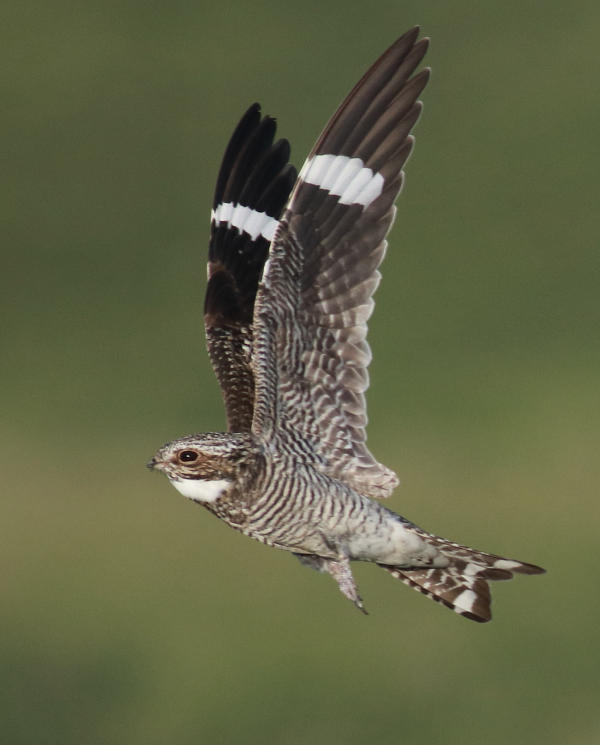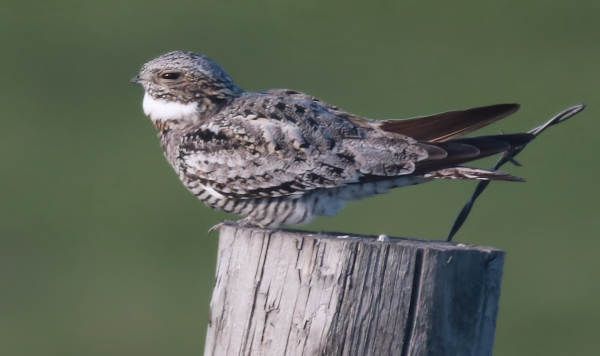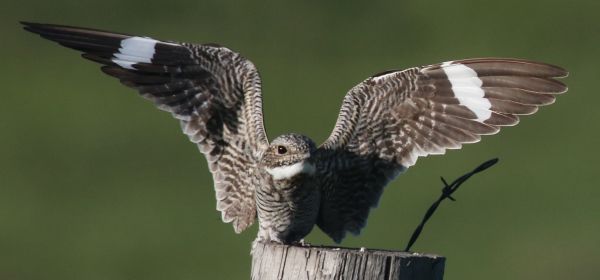
An hour of active Common Nighthawk behavior provided a variety of conditions and activities to photograph. This exciting image shows a nighthawk in detail, emphasized by the narrow depth of field that created a pleasing out of focus green background (f5 aperture).
|
This has been a remarkable spring for witnessing and documenting behaviors among birds I thought I knew well. Several have been revealing themselves to me in new ways behaviorally. That was true again Monday evening, when I turned east onto the Lost Road. This three-mile dirt lane is magical during late spring and summer, and the landscape was exceptionally alive with birds and birdsongs as I slowly motored up and down the hilly landscape that stretches before you as though you have traveled back in time to a prairie that stretches as far as the eye can see – only the historic herds of buffalo are missing.
There a special community of birds assembles: Upland Sandpipers, Common Nighthawks, Wilson’s Snipe, Marbled Godwits, Killdeer, Western and Eastern Kingbirds, Western Meadowlarks, Clay-colored Sparrows, and an invading population of Orchard Orioles. It was a beautiful windless evening with the sun low in the west and the verdant plains alive with avian activities, songs, and calls – ever moving, ever changing.
It was a nighthawk that created a scenario that was like watching a news story. News because I’ve never seen nighthawks call or display from a perch, they don’t even preen; yet this one did all of those things. He puffed his white throat feathers outward and called, opening its mouth so widely that it seemed as though half its head opened up. I tried to photograph its mouth wide open, but it called so fast and so irregularly that I missed it over and over again, even though I tried intently to anticipate the action.
While focused on the calling nighthawk, I changed my aperture from f8 to f5 to throw the background out of focus, thereby emphasizing the bird all the more. To check the affect, I reviewed a couple photos in my camera’s monitor.
It was obvious something was unusual, or delightful, about this bird at this time, so I waited a while to see what might transpire. The obviously fired up nighthawk began preening with its tiny beak – until three bullies showed up. A trio of Barn Swallows began diving at the noble nighthawk, which made it call and thereby open its mouth each time a swallow made it flinch during a dive-by.
At one point the nighthawk spread it wings in reaction to an especially close swallow dive, which provided a quick chance to get that photo – and I got it! The nighthawk even took flight at one point due to the intensity of the swallow dives, but perched again after just a couple wingbeats. After a few more aggressive swallow dives, the nighthawk took flight, and the trio of swallow bullies circled in tight formation, to emphasize their dominance I guess.
Territorial Flights

Unlike any other nighthawks Paul has observed and photographed, this male was actively calling and displaying its white throat plumage that could be seen from a considerable distance.
|
I continued down the road to the edge of the Missouri Coteau escarpment, enjoying the views and birds along the way, then returned westward. About halfway back, I noticed another nighthawk; this one circling and diving, calling all the while. It was obviously declaring its territory, and its availability for a mate. In moments it became clear there was a central point at a low spot surrounded by prairie hills that the nighthawk was diving toward and flying low above it, then climbing high again, re-orienting and diving toward the low area. It would seem it was claiming this location as its territory and perhaps pointing out a potential nesting location as it continued diving, calling, circling low over a central area, then climbing high, undulating, calling, and diving more.
It was the first show of this behavior I’ve ever witnessed during my decades of prairie studies, and it continued for some time with a few twists and turns as I stopped to take it in and document the action as best I could with my camera. It provided some spirited photo ops, like when the nighthawk flew directly above me, and when he periodically dived like a falcon, stooping almost straight downward, twisting this way and that, until it abruptly pulled up to produce a “varoom” sound as it quickly reversed course upward.
Twice during the nighthawk’s flights it perched on a post near the road – the post at the highest point on that hill. There it stood, facing me (with the sun at my back), drooping its wings at its side, and expanding its white throat feathers, while I watched and photographed. At times, it seemed like I was the point of his territorial attention, and that post would prove an important location for a favorite photo opportunity that transpire after a surprise chase.
The Chase
Suddenly, three other nighthawks approached in what appeared to be a low chase. I was surprised they would enter this location with the displaying male so active, and sure enough, he took after the threesome. Actually, he may have joined the chase, and the four-some continued the low flight, turning this way and that, with the lone female leading the way (although realizing the males were chasing a single female was only evident in my photos). The males followed the female with their white throat feathers extended cross-country over this hill and that one (the female only showing subdued tan throat coloration).

Harassed by a trio of diving Barn Swallows, the territorial nighthawk reacted to a particularly close dive by standing up and spreading its long wings to fend off the next swallow.
|
The territorial male soon returned, although the three-some continued their low chase flight to the east. The male re-outlined his territory in flight, and during a low flight returned to perch on the post near me. As it approached, I hoped the autofocus would connect with him; and it did, as I took a memorable photo of the nighthawk landing with its wings extended wide horizontally showing its expanded chin feathers and its tiny feet reaching forward to land.
For this photo, I was happy to have changed the aperture back to f8 earlier to provide a bit more depth of field to make sure the entire bird would be within the area of focus as it landed. At the same time, the distant landscape behind the bird would not be in focus, providing a pleasing green background. The f8 aperture also provided an ample shutter speed to stop the motion approaching bird, especially to get a sharp image of the face of the nighthawk. It’s a photo I will long appreciate and share with people.
I see motionless nighthawks regularly along the Lost Road, and I usually try to photograph them, partly to document the varied shades of gray they are colored, partly because they are usually approachable, and partly to make a little album of Lost Road nighthawks. In hindsight it seems that hour of nighthawk action was an anomaly, even though it certainly happens in my absence – it’s just a matter of timing – for me, and the nighthawks. Even so, if it was happening Monday evening, it should happen Tuesday too – right? But I saw no more territorial nighthawk action during Tuesday or Friday visits to the area.

That epitaph underlines the importance of taking advantage of the chance to photograph any bird to the fullest when you have a chance. Stay a little longer, see what might happen next. You never know what you might miss, or if the action transpires, if it will ever happen in your presence again – regardless of how often you drive down the Lost Road to absorb the essence of that glorious prairie landscape.
Article and photos by Paul Konrad
Share your bird photographs and birding experiences at editorstbw2@gmail.com